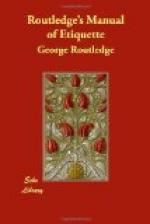Whatever we may be inclined to believe with regard to this disputed question, there can be no doubt of the wide-spread popularity which for many years was enjoyed by the Polka. When first introduced, in 1843, it was received with enthusiasm by every capital in Europe; and it effected a complete revolution in the style of dancing which had prevailed up to that period. A brisk, lively character was imparted even to the steady-going quadrille; the old Valse a Trois Temps was pronounced insufferably “slow;” and its brilliant rival, the Valse a Deux Temps, which had been recently introduced, at once established the supremacy which it has ever since maintained. The galop, which had been until this period only an occasional dance, now assumed a prominent post in every ball-room, dividing the honours with the valse.
But all these dances, though modified in character by the introduction of the Polka, were for a time thrown into the shade by this new claimant upon public favour. Its popularity was unrivalled in the annals of dancing. Rich and poor, young and old, grave and gay, all were alike smitten by the universal Polka mania. All flocked to take lessons in this new and fascinating dance; and the professors of its mysteries fairly divided public attention with the members of the Anti-Corn-Law League, then holding their meetings at Drury Lane Theatre. We will even go so far as to say that Messrs. Bright and Cobden were scarcely more anxious to destroy the vexatious Corn Laws than were these worthy Polka-maniacs to create corn laws of their own, which, if more innocent, were equally undesirable.
For many years the Polka maintained its position as the universal favourite; but, during the last five or six seasons, its popularity has slowly but surely declined. It is never danced now in the ball-rooms of the aristocracy, but the middle classes have not yet quite discarded their old friend, though even amongst their programmes its name rarely occurs.
Perhaps no dance affords greater facilities for the display of ignorance or skill, elegance or vulgarity, than the Polka. The step is simple and easily acquired, but the method of dancing it varies ad infinitum. Some persons race and romp through the dance in a manner fatiguing to themselves and dangerous to their fellow-dancers. Others (though this is more rare) drag their partner listlessly along, with a sovereign contempt alike for the requirements of the time and the spirit of the music. Some gentlemen hold their partner so tight that she is half suffocated; others hold her so loosely that she continually slips away from them. All these extremes are equally objectionable, and defeat the graceful intention of the dance. It should be performed quietly, but with spirit, and always in strict time. The head and shoulders should be kept still, not jerked and turned at every step, as is the manner of some. The feet should glide swiftly along the floor—not hopping or jumping as if the boards were red-hot.




